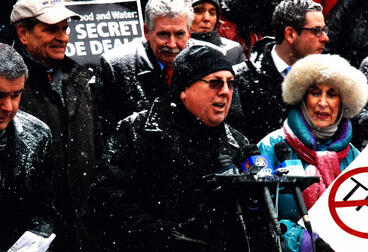Don’t be fooled by the positive phrasing of the Republican Party and corporate agenda’s anti-union crusade. Right-to-Work has a nice ring to it. It sounds very inviting. Come on down and be the next up to exercise your right to work. Its definition is “relating to or promoting a worker’s right not to be required to join a labor union” and is encouraged by the individual state. To those represented by a union, we understand the true definition of right-to-work as an employer’s right to intimidate, oppress, exploit and commodify workers due to the absence of legal representation. The right for a worker to be subjected to the nature of a boss. There is, of course, the Federal Labor Relations Act (NLRA) of 1935 that ensured federal protection of worker’s rights, but without counsel that is independent of the employer on the job, many employees are less inclined to seek the NLRA unless there are egregious actions or conditions pressed against the employee by the employer. Indeed, right-to-work is a state government-sanctioned word play intimidation measure against freedom of association.
A union wins the right to represent a specific work force through the democratic process of an election where the majority vote wins. Consistent with democratic elections, majority rules. After a successful majority vote a union expects members to pay dues for its services, as does every service provider and that payment is collected in the form of dues from all employees in question.
But in the case of successful elections in right-to-work states there is no mandate requiring workers to pay dues for union representation. Free representation? Service without a fee is an unsustainable proposition and is a completely absurd contradiction and troublesome practice within a capitalist system where only specific democratic elections for representation are not recognized and services are not paid for. Yet going against the results of democratically-elected officials and where every product and service charges a fee, right-to-work states refuse to recognize a union’s representation for all workers in a specific election and the right to charge a fee for representation.
Common sense and reality tells us that if someone is not compelled to pay for a service they likely will not. Why pay for a service if you do not have to? One, it is unfair for the workers who continue to pay dues. And two, it is sure to quickly put that venture out of business. While all members enjoy the benefits of a union, without the mandate for all to pay dues, the union becomes less effective. It is simple economics. When an agency is underfunded it is impossible to adequately perform its obligations and as workers suffer that deficiency, others may stop paying dues leading to the eventual collapse of the union.
Currently there are 28 right-to-work states in the United States. The National Right To Work Foundation, a corporate machine, offers free legal aid for workers to refuse union representation and calls its work defending “worker freedom.” This nefarious organization of malevolent conspirators should call their work the crusade for “unchecked corporate aggression.” Thanks to business benefactors they remain solvent, wreaking havoc on virtuous union organizers and workers who want union representation.
This is the basic principle exercised by New York City non-union construction employers who are against city council initiative 1447. If passed into law, 1447 will mandate commensurate apprenticeship safety training in order to improve education and safety requirements resulting in safer New York City construction work sites. The Building Trades members at the 1447 rally at City Hall earlier this year watched with empathy as ridiculously outnumbered non-union workers briefly turned out to stand against job site safety. Non-union contractors have fooled and forced their work force into promoting ignorance and increased occupational danger. The real agenda of the National Right To Work Foundation is not the ethical sounding “worker freedom”; its goal is to block worker’s rights, education, self-improvement, social mobility and safety.
The National Labor Relations Act (NLRA) enacted in 1935 by President Franklin Delano Roosevelt, on its official website offers its accepted definition, “an independent federal agency that protects the rights of individual employees to join together, with or without a union, to improve their wages and working conditions, to determine to have unions as their bargaining representative and to refrain from any of these activities. It acts to prevent unfair labor practices committed by private sector employers and unions”; also, “to protect the rights of employees and employers, to encourage collective bargaining, and to curtail certain private sector labor and management practices, which can harm the general welfare of workers, businesses and the U.S. economy.” The basic premise is to create workplace harmony under the guise of the U.S. Constitution First Amendment guaranteeing freedom of association.
But the initial intention of the NLRA was a response to injustices suffered by the American working class in the absence of worker’s rights legislation by mitigating employer hegemony. The NLRA was a compliment to the U.S. Constitution, the nation’s premiere document rule of law that was written in the spirit of an agrarian nation before the industrial revolution. Indeed, the NLRA was successful in its purpose until the Taft-Hartley Act of 1947. The Taft-Hartley Act, by reinforcing guarantees to businesses already existing, weakened the NLRA protection of workers leading to the corporate attack on state’s rights that has expanded right-to-work to more states.
In the words spoken by our great nation’s first President, as debate about the extent of government intervention in individual lives was most contentious, George Washington said, “men will not adopt and carry into execution measures best calculated for their own good without the intervention of a coercive power.” That coercive power is the body of law that the United States was built upon, a governing body of representatives democratically elected and paid by the people‰Û_Sounds exactly like the definition of union representation.
(The following article was written by Chris Kromm)
The Racist Roots of ‘Right To Work’ Laws
Republican lawmakers in Michigan ‰ÛÓ birthplace of the United Auto Workers and, more broadly, the U.S. labor movement shocked the nation by becoming the 24th state to pass “right-to-work” legislation, which allows non-union employees to benefit from union contracts.
While Michigan’s momentous decision has received widespread media attention, little has been said about the origins of “right-to-work” laws, which find their roots in extreme pro-segregationist elements in the 1940s South.
The history of anti-labor “right-to-work” laws starts in Houston. It was there in 1936 that Vance Muse, an oil industry lobbyist, founded the Christian American Association with backing from Southern oil companies and industrialists from the Northeast.
As Dartmouth sociologist Marc Dixon notes in his fascinating history of the period, “The Christian American Association was the first in the nation to champion the ‘Right-to-Work’ as a full-blown political slogan.”
Muse was a fixture in far-right politics in the South before settling into his anti-labor crusade. In his 1946 book “Southern Exposure,” crusading journalist Stetson Kennedy wrote:
“The man Muse is quite a character. He is six foot four, wears a ten-gallon hat, but generally reserves his cowboy boots for trips North. Now over fifty, Muse has been professionally engaged in reactionary enterprises for more than a quarter of a century.”
As Kennedy described, these causes included opposing women’s suffrage, child labor laws, integration and growing efforts to change the Southern political order, as represented in the threat of Roosevelt’s New Deal.
Muse’s sister and associate at the Christian American Association, Ida Darden, openly complained about the First Lady’s “Eleanor Clubs” saying they (as related by Kennedy):
...stood for “$15 a week salary for all black house help, Sundays off, no washing and no cleaning upstairs.” As an afterthought, she added, “My black maid wouldn’t dare sit down in the same room with me unless she sat on the floor at my feet!”
Allowing herself to go still further, the little lady went on to say, “Christian Americans can’t afford to be anti-Semitic, but we know where we stand on the Jews, all right.
The Association also suspected Catholics, which Dixon notes caused the downfall of their crusades in neighboring Louisiana.
But for far-right conservatives like Muse, as well as industry groups like the Southern States Industrial Council, labor, including black labor, posed an especially dangerous threat in Texas. Thanks to a burgeoning wartime economy, along with labor organizing drives spearheaded by the Congress of Industrial Organizations and, to a lesser extent, the American Federation of Labor, unions were rapidly growing in Texas. After hovering around 10 percent of the workforce during the 1930s, union membership exploded by 225 percent during the next decade.
Muse and the Christian American Association saw danger. Not only were the unions expanding the bargaining power and therefore improving the wages and working conditions of working-class Texans, they also constituted a political threat. The CIO in particular opposed Jim Crow and demanded an end to segregation. Unions were an important political ally to FDR and the New Deal. And always lurking in the shadows was the prospect of a Red Menace, stoked by anti-communist hysteria.
Working in concert with segregationists and right-wing business leaders, Muse and the Association swiftly took action. Their first step in 1941 was to push an “anti-violence” bill that placed blanket restrictions on public union picketing at workplaces. The stated goal was to ensure “uninterrupted” industrial production during World War II, although Texas had the fewest number of strikes in the South and the law applied to all industries, war-related or not.
Their success with the “anti-violence” bill spurred Muse and the Christian American å_Association to push for ‰ÛÓ and pass ‰ÛÓ similar laws throughout the South. Mississippi adopted an anti-violence statute in 1942; Florida, Arkansas and Alabama passed similar laws in 1943. It also emboldened them to take on a much bigger prize: ending the ability of labor groups to run a “closed shop,” where union benefits extend only to union members.
In 1945, the Christian American Association along with allies cemented in earlier anti-union legislative battles, including the Fight for Free Enterprise and the vehemently anti-union Texas Lt. Gov. John Lee Smith introduced a right-to-work bill in Texas. It passed the House by a 60 to 53 margin, but pro-New Deal forces stopped it in the State Senate. Two years later, thanks to a well-funded campaign from the Association and industry and internal divisions between the craft-oriented AFL and the more militant CIO ‰ÛÓ Texas’ right-to-work bill was signed into law.
While working to pass right-to-work legislation in Texas, Muse and the Association took their efforts to Arkansas and Florida, where a similar message equating union growth with race-mixing and communism led to the passage of the nation’s first right-to-work laws in 1944. In all, 14 states passed such legislation by 1947, when conservatives in Congress successfully passed Section 14(b) of the Taft-Hartley Act, enshrining the right of states to pass laws that allow workers to receive union benefits without joining a union.
Civil rights leaders like Martin Luther King, Jr., who saw an alliance with labor as crucial to advancing civil rights as well as economic justice for all workers, spoke out against right-to-work laws; this 1961 statement by King was widely circulated recently during Michigan’s labor battles:
“In our glorious fight for civil rights, we must guard against being fooled by false slogans, such as ‘right to work.’ It is a law to rob us of our civil rights and job rights. Its purpose is to destroy labor unions and the freedom of collective bargaining by which unions have improved wages and working conditions of everyone‰Û_Wherever these laws have been passed, wages are lower, job opportunities are fewer and there are no civil rights.”
Interestingly, 11 years later, Kansas also passed a right-to-work law, with the support of Texas-born energy businessman Fred Koch, who also viewed unions as vessels for communism and integration. Koch’s sons Charles and David went on to form the Tea Party group Americans for Prosperity, which pushed for the Michigan right-to-work measure and is now advocating for states that already have such laws, like North Carolina and Virginia, to further enshrine them in their state constitutions.
And what about Muse? According to the Texas State Historical Association:
Muse died on October 15, 1950, at his Houston home, where his efforts with the Christian Americans had originated. At the time of his death he was working on a right-to-work amendment to the federal Constitution.
Michigan, birthplace of the United Auto Workers and, more broadly, the U.S. labor movement ‰ÛÓ shocked the nation by becoming the 24th state to pass “right-to-work” legislation, which allows non-union employees to benefit from union contracts.
While Michigan’s momentous decision has received widespread media attention, little has been said about the origins of “right-to-work” laws, which find their roots in extreme pro-segregationist and anti-communist elements in the 1940s South.
Date Posted


